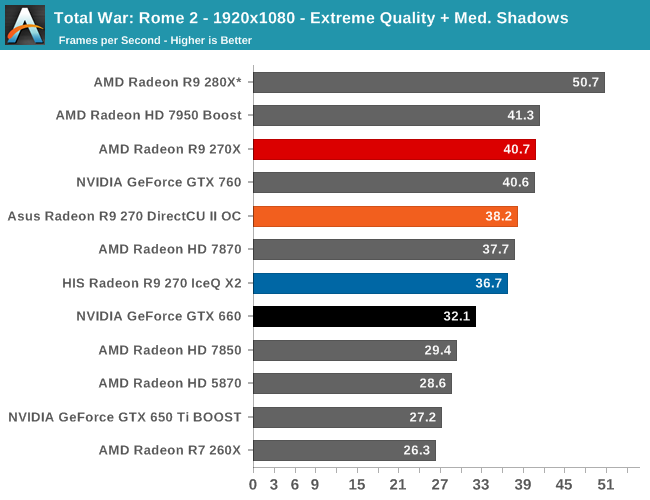The AMD Radeon R9 270X & R9 270 Review: Feat. Asus & HIS
by Ryan Smith on November 13, 2013 12:01 AM ESTTotal War: Rome 2
The second strategy game in our benchmark suite, Total War: Rome 2 is the latest game in the Total War franchise. Total War games have traditionally been a mix of CPU and GPU bottlenecks, so it takes a good system on both ends of the equation to do well here. In this case the game comes with a built-in benchmark that plays out over a forested area with a large number of units, definitely stressing the GPU in particular.
For this game in particular we’ve also gone and turned down the shadows to medium. Rome’s shadows are extremely CPU intensive (as opposed to GPU intensive), so this keeps us from CPU bottlenecking nearly as easily.


Total War: Rome 2 is another solid victory for the 270 series. At our highest 1080p settings all cards can average better than 30fps, with the 270X outright tying the GTX 760 in the process. Otherwise for the 270, it can best the GTX 660 by over 15%.
Making one other quick comparison, the 270 looks especially good opposite the 7850 here. Not only does it crack 30fps when the 7850 couldn’t, but its 25% performance advantage is the largest lead we’ll see today.










59 Comments
View All Comments
Waveblade - Wednesday, November 13, 2013 - link
It's like different people work on different products!Roland00Address - Wednesday, November 13, 2013 - link
A commandment of any cell phone reviews, thou shall not rush battery life tests.Tetracycloide - Wednesday, November 13, 2013 - link
Be thou particularly careful testing battery life when thine available anecdotes vary wildly. Be thou definitive.slayerxj - Wednesday, November 13, 2013 - link
I may not read the article very carefully, and I keep wondering that why 280X has a star behind it.Gigaplex - Wednesday, November 13, 2013 - link
I'm getting a little tired of this TDP nonsense. Two cards with the same TDP from the same product family of the same manufacturer that clearly consume different amounts of power - the TDP numbers are now meaningless. And don't get me started on Intels SDP.yannigr - Wednesday, November 13, 2013 - link
If both are under 150W, then where is the problem? Maybe R9 270 consumes close to 130W-140W and not 150W, giving the necessary room to AMD's partners to oc the chip without passing the 150W limit.dylan522p - Wednesday, November 13, 2013 - link
OCed 270 is 270xslapdashbr - Monday, November 18, 2013 - link
Under 150W means it only needs one 6-pin power connector (like the 7850 or 660 which it replaces/competes with) and in general is much more power-efficient. The 270 (non-x) is aimed more at builders with power limits or old systems that can't support a dual-6-pin GPU, or perhaps computational tasks where performance per watt is more important than performance per card. The 270x is full-powered but less efficient and is better suited for gamers and tweakers. I wouldn't get a 270 to save $20 unless the lower power limit was important, in which case it's actually a good buy, as it should still edge out a gtx 660 while staying under 150W total power.dylan522p - Wednesday, November 13, 2013 - link
SDP at least makes sense.maximumGPU - Wednesday, November 13, 2013 - link
quick comment on the DCUII coolers from asus. I too have been very impressed with them. my goal was silent yet powerful computing, and the DCUII cooler on my GTX670 plays that part admirably.